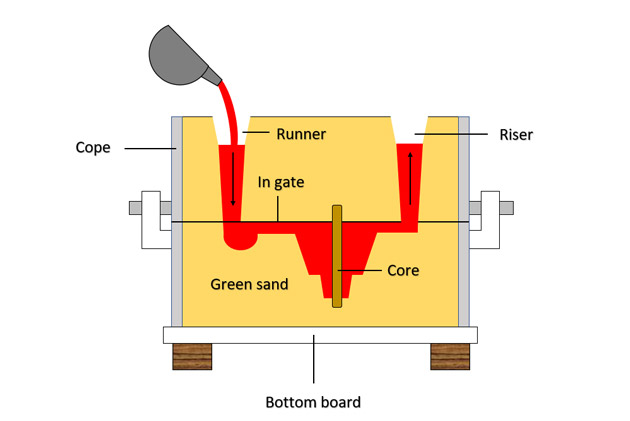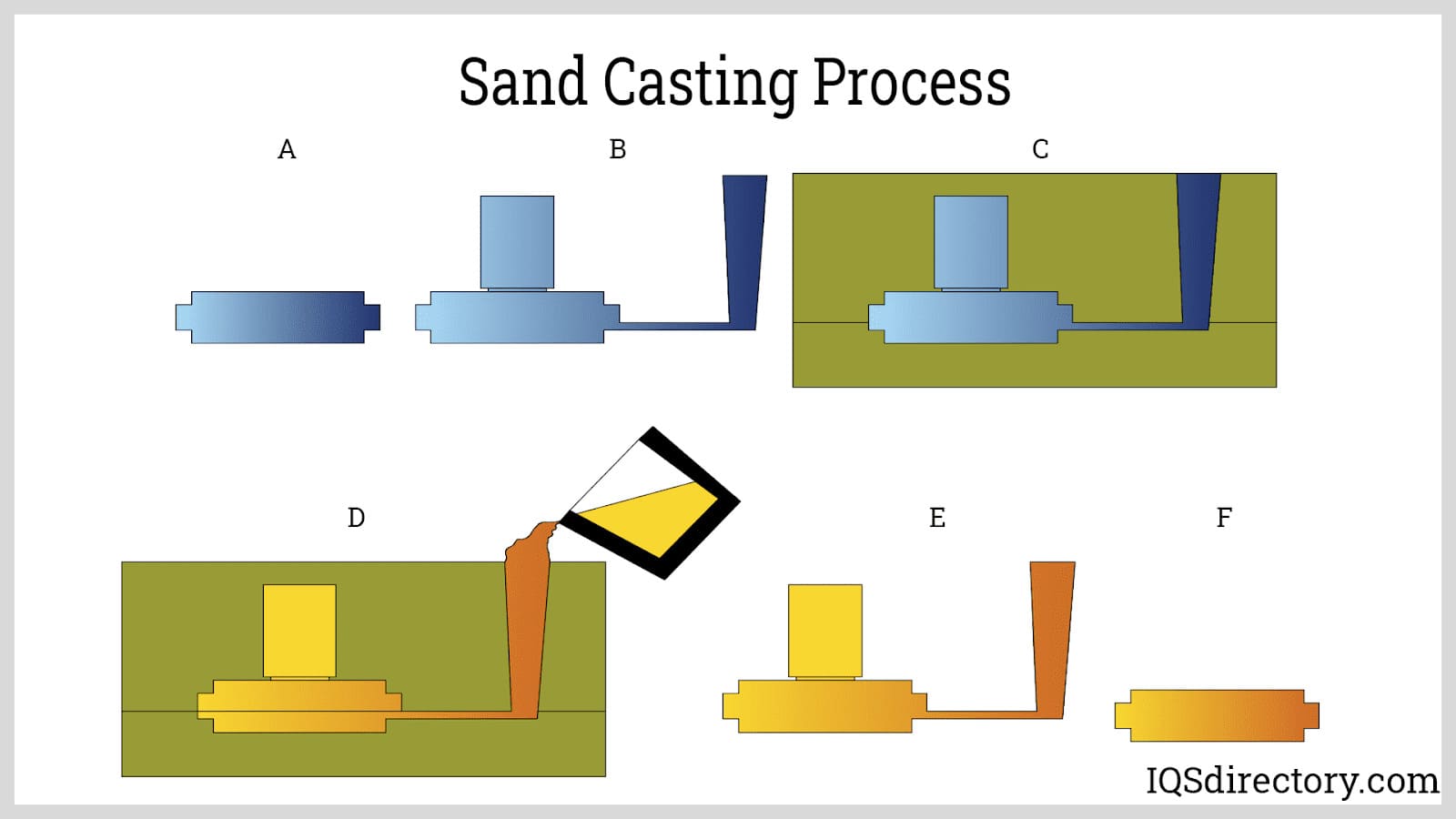The value of Aluminum Foundry Wisconsin in casting projects
Just How Aluminum Foundry Adds To Developments in Aerospace Design
Aluminum factories are essential to advancements in aerospace engineering. They generate light-weight, high-strength elements that are important for modern-day aircraft. With advanced spreading methods, these foundries develop complicated geometries that improve architectural integrity. Additionally, the development of premium Aluminum alloys sustains the market's emphasis on gas effectiveness and sustainability. Obstacles remain in the manufacturing procedure. Comprehending these elements discloses the profound effect of Aluminum on air travel's future.
The Value of Lightweight Materials in Aerospace Layout
As the aerospace industry proceeds to advance, the importance of light-weight products comes to be progressively evident. The need for effectiveness and sustainability drives engineers to focus on making use of products that reduce general weight without compromising architectural stability. Light-weight materials, specifically Aluminum, play a vital duty in enhancing gas performance, improving payload capacity, and raising the general efficiency of airplane.
The combination of these materials allows for ingenious styles, allowing manufacturers to create even more wind resistant forms that can endure extreme conditions. The decrease in weight not just decreases functional prices yet also adds to a decreased environmental footprint, aligning with global efforts towards sustainability in aviation.
Advanced Spreading Techniques in Aluminum Foundries
Advanced casting methods in Aluminum factories play a critical role in aerospace design by allowing the production of light-weight and specific elements. Technologies in mold layout and accuracy spreading procedures are essential in achieving perfect performance and architectural integrity. Additionally, the development of lightweight alloys enhances the total performance and performance of aerospace applications.
Ingenious Mold And Mildew Layout
Cutting-edge mold design plays a vital function in the performance and efficiency of Aluminum factories, specifically within the aerospace market. By leveraging sophisticated products and strategies, modern-day mold and mildews can be crafted to endure heats and pressures, ensuring peak performance during the spreading procedure. These layouts typically incorporate complex geometries that permit for the production of lightweight yet structurally audio components, vital for aerospace applications. In addition, the use of computer-aided design (CAD) software application assists in precise modeling, making it possible for foundries to replicate and fine-tune mold and mildew styles prior to physical manufacturing begins. This not only enhances the top quality of cast components however likewise lowers waste and lead times, leading to considerable price financial savings. In general, cutting-edge mold and mildew layout is a foundation of development in Aluminum Foundry technology for aerospace engineering.
Accuracy Casting Processes
The efficiency of cutting-edge mold designs seamlessly incorporates with precision casting processes, which are vital for generating high-quality Aluminum components in aerospace engineering. These processes, consisting of sand spreading, pass away spreading, and investment casting, ensure the production of intricate geometries with tight tolerances. Advanced techniques like vacuum cleaner spreading and stress pass away casting boost the integrity and surface area finish of the end products. Precision casting lessens product waste while making the most of the mechanical residential properties of Aluminum, important for aerospace applications. In enhancement, using real-time surveillance and advanced simulation tools throughout the casting procedure enables for instant modifications, leading to boosted quality control. Collectively, these accuracy casting procedures placement Aluminum shops at the center of aerospace technology, supporting the sector's need for reliability and performance.
Lightweight Alloy Growth
As aerospace designers look for to improve fuel performance and performance, light-weight alloy growth comes to be a crucial emphasis in Aluminum shops. These shops employ advanced spreading techniques to produce alloys that supply exceptional strength-to-weight proportions. Developments in alloy make-up, consisting of the unification of aspects like lithium and magnesium, enable the production of materials that endure severe problems while decreasing total airplane weight. Techniques such as die spreading and investment spreading assist in the accuracy production of complicated forms, which are important for aerospace applications. Additionally, recurring research aims to maximize these alloys for enhanced mechanical homes and increased longevity. By prioritizing light-weight alloy advancement, Aluminum factories significantly add to the development of aerospace design, leading the way for more sustainable and efficient airplane layouts.

Enhancing Structural Stability Via Aluminum Elements
Aluminum elements supply substantial advantages in enhancing structural stability within aerospace design. Their lightweight nature adds to overall efficiency while maintaining toughness, which is vital for airplane performance. Furthermore, the tension resistance residential or commercial properties of Aluminum help guarantee the durability and dependability of aerospace structures under different operational problems.
Light-weight Material Advantages
While traditional products often compromise weight for toughness, using Aluminum elements in aerospace design uses considerable advantages in structural honesty. Aluminum's light-weight nature contributes to total layout efficiency, allowing for more structured aircraft that consume much less fuel, thereby improving sustainability. The material's exceptional strength-to-weight ratio warranties that elements maintain longevity without including unneeded mass. This top quality cultivates enhanced performance and agility in flight, along with optimized haul capabilities. Additionally, Aluminum's resistance to deterioration prolongs the life-span of aerospace structures, minimizing maintenance prices and enhancing safety and security. As makers increasingly take on Aluminum alloys, the aerospace industry experiences a transformative change in the direction of extra efficient and effective design services that focus on both performance and ecological responsibility.
Tension Resistance Characteristics
Various materials have unique buildings, Aluminum's exceptional stress resistance stands out as a critical aspect in boosting the structural honesty of aerospace elements. This resistance plays a crucial function in ensuring that airplane can hold up against different operational anxieties, including tiredness, impact, and environmental conditions. Aluminum alloys, especially crafted for aerospace applications, display high tensile stamina while keeping lightweight qualities, enabling engineers to make much more reliable structures - Aluminum Foundry. Furthermore, the capacity of Aluminum to endure cyclic loading without considerable contortion adds to the long life and reliability of aerospace elements. As developments proceed in Aluminum Foundry methods, the growth of stress-resistant Aluminum elements assures additional improvements in efficiency, safety, and efficiency throughout the aerospace industry, strengthening Aluminum's function as a preferred material in contemporary design
Gas Efficiency Improvements Driven by Aluminum Innovations
As the aerospace industry looks for to enhance gas efficiency, innovative uses of Aluminum have emerged as a vital service. Aluminum's lightweight nature notably lowers aircraft weight, allowing for lower gas consumption during trip. This decrease in weight is crucial, as also tiny reductions can lead to substantial improvements in general gas economy.
Advanced Aluminum alloys, developed for boosted strength and toughness, enable get more makers to produce elements that maintain structural honesty while decreasing mass - Aluminum Foundry. Additionally, the integration of Aluminum in airframes and engine parts helps with boosted aerodynamics, adding to reduced drag and increased efficiency
The fostering of Aluminum read here in aerospace not only satisfies the need for fuel-efficient design however also lines up with regulatory stress for lower discharges. As these developments remain to advance, they play a substantial role in setting brand-new standards for fuel effectiveness, guaranteeing that the aerospace industry can satisfy expanding environmental and economic obstacles.

The Function of Aluminum in Sustainable Air Travel Practices
The increasing focus on lasting aeronautics techniques has actually placed Aluminum as a necessary material in the mission for greener airplane layout. Known for its lightweight residential properties, Aluminum substantially decreases aircraft weight, resulting in lower fuel intake and emissions. Its recyclability further improves its sustainability profile, as Aluminum can be recycled indefinitely without loss of quality. This particular supports a circular economic situation within the aeronautics sector, reducing waste and resource depletion.
Furthermore, developments in Aluminum alloys have boosted their toughness and rust resistance, permitting longer life span and lowered maintenance needs. These innovations facilitate the growth of a lot more efficient airplane structures, adding to general sustainability initiatives. Furthermore, Aluminum's thermal conductivity plays a critical role in energy-efficient designs, boosting systems such as warm exchangers. Jointly, these features highlight Aluminum's critical duty in advancing sustainable aviation, straightening with international efforts focused on minimizing the environmental influence of air travel.
Difficulties Faced by Aluminum Foundries in Aerospace Production
While Aluminum foundries play a crucial role in aerospace manufacturing, they face substantial challenges that can affect production effectiveness and top quality. One significant obstacle is the rigid top quality control criteria needed in the aerospace industry. Any type of problem can endanger safety and security and performance, necessitating strenuous examination procedures that extend production timelines. Furthermore, shops frequently emulate fluctuating basic material expenses, which can affect prices and productivity. The complexity of Aluminum alloys utilized in aerospace applications more makes complex the manufacturing process, as specific formulations are vital for attaining wanted mechanical residential properties. Knowledgeable labor scarcities impede the capacity to preserve top quality production degrees. Ultimately, ecological laws enforce limitations on discharges and waste administration, needing factories to invest in sustainable practices, which can be cost-prohibitive. These aspects collectively create a landscape where Aluminum shops need to constantly adapt to meet the evolving demands of aerospace production while making sure security and compliance.
Future Trends in Aluminum Applications for Aerospace Design
With advancements in modern technology and boosting demands for performance, the future of Aluminum applications in aerospace design is positioned for substantial change. The integration of cutting-edge Aluminum alloys and composites is anticipated to enhance strength-to-weight proportions, causing more fuel-efficient airplane styles. On top of that, improvements in additive manufacturing methods will permit for the production of intricate Aluminum structures that were formerly impossible, optimizing efficiency and decreasing waste.

Lasting practices will play a crucial role, with an expanding emphasis on recycling Aluminum to reduce ecological impact. The aerospace field is most likely to embrace smarter manufacturing processes, such as automation and fabricated knowledge, ensuring better and precision in Aluminum elements. Moreover, collaborations in between Aluminum shops and aerospace firms will certainly cultivate r & d, leading the way for new applications that satisfy the strict demands of modern aerospace design - Aluminum Foundry. Generally, the future looks guaranteeing for Aluminum's duty in shaping the skies
Regularly Asked Inquiries
What Are the Ecological Effects of Aluminum Manufacturing in Aerospace?
The ecological influences of Aluminum production in aerospace include significant energy usage, greenhouse gas discharges, and environment interruption. In addition, mining procedures can result in soil destruction and water contamination, raising concerns concerning sustainability and ecological balance.
How Does Aluminum Compare to Various Other Products in Aerospace Applications?
Aluminum supplies a special combination of look at here now light-weight buildings, corrosion resistance, and cost-effectiveness contrasted to other products. Its high strength-to-weight proportion makes it specifically advantageous for aerospace applications, improving gas efficiency and general efficiency in aircraft layout.
What Qualifications Do Aluminum Foundry Workers Need for Aerospace Projects?
Aluminum Foundry workers call for specific training in metallurgy and spreading methods, in addition to expertise of aerospace industry standards. Certifications in quality assurance and safety procedures are also essential to assure compliance with rigid aerospace project demands.
Exist Any Security Interest In Using Aluminum in Aerospace Design?
Security issues concerning Aluminum in aerospace design include susceptibility to anxiety, corrosion, and exhaustion cracks. Proper treatment and alloy selection are essential to alleviate these risks, making sure structural stability and general safety in aerospace applications.
Just How Does Aluminum Recycling Benefit the Aerospace Sector?
Aluminum recycling considerably profits the aerospace market by lowering material costs, reducing environmental impact, and conserving power. This lasting technique boosts the sector's effectiveness while advertising the usage of lightweight, high-performance components in aircraft production.
Advanced spreading strategies in Aluminum shops play an important duty in aerospace design by allowing the manufacturing of lightweight and specific elements. Ingenious mold design plays an important role in the effectiveness and efficiency of Aluminum shops, particularly within the aerospace sector. As aerospace engineers seek to improve fuel efficiency and efficiency, light-weight alloy advancement ends up being an essential emphasis in Aluminum shops. Aluminum alloys, particularly engineered for aerospace applications, show high tensile strength while keeping lightweight qualities, enabling designers to design much more reliable structures. Collaborations in between Aluminum shops and aerospace companies will certainly cultivate research study and development, leading the method for new applications that meet the rigorous demands of modern aerospace engineering.